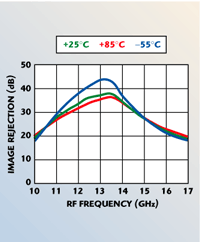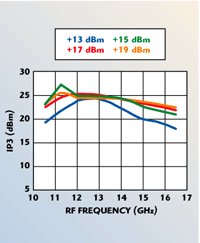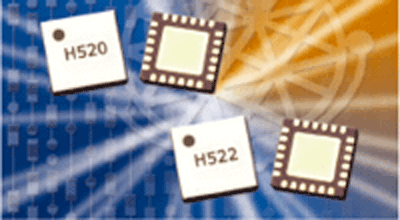
As a supplier of microwave and millimeter-wave components, Hittite Microwave Corp.’s products are found in numerous designs within the microwave radio, point-to-point/multipoint, VSAT and test equipment markets. In particular, the company’s microwave and millimeter-wave mixer ICs have been used to implement image reject mixer (IRM) and single sideband (SSB) upconverter circuits. In receive chain applications, an IRM can eliminate the need for a costly preselect filter, which degrades system noise figure. Similarly, matched pairs of double-balanced mixers can be combined with an in-phase splitter and a quadrature hybrid to create a single sideband upconverter that neatly terminates the undesired sideband. While the performance benefits are significant, the implementation of hybrid MIC or PCB-based image reject mixers or single sideband upconverters can come with their own set of challenges.
By leveraging the company’s expertise in passive double-balanced mixer technology, nine new MMIC I/Q mixer die (HMC520 through HMC528) and two SMT MMIC I/Q mixers (HMC520LC4 and HMC522LC4) have been introduced that cover an RF/LO frequency range of 4 to 32 GHz. Each of the mixers in this family provide a single-ended LO input port which is fed through an on-chip quadrature hybrid before driving two (I and Q) double-balanced mixers. An in-phase power splitter routes the single-ended RF input to the I and Q mixers while an off-chip IF hybrid is used to inject (transmit mode) or select (receive mode) the desired IF band.

Fig. 1 HMC522 GaAs MMIC I/Q mixer's conversion gain vs. LO drive level (as an IRM with external IF hybrid).

Fig. 2 HMC522 GaAs MMIC I/Q mixer's image rejection vs. temperature (as an IRM with external IF hybrid).

Fig. 3 HMC522 GaAs MMIC I/Q mixer's input vs. LO drive level (as an IRM with external hybrid).
Each of these mixers is fabricated using a reliable, mature and production-qualified GaAs MESFET process. In addition, this process allows the design of extremely compact baluns and couplers, which significantly reduce the size of the I/Q mixer die as compared to alternate solutions.

Each of these products offer wide IF bandwidth of up to 3.5 GHz, low conversion loss, high input IP3 to +28 dBm and excellent RF-to-LO isolation. Compared with a hybrid-based implementation, these I/Q MMIC mixers offer significantly reduced circuit area, consistent performance, and excellent amplitude and phase balance as a result of their monolithic construction. Figures 1, 2 and 3 show the HMC522 11–16 GHz I/Q mixer’s typical conversion gain, image rejection and input IP3 performance when it is configured as an image reject mixer using an external IF hybrid. The HMC522 provides greater than 35 dB of image rejection at midband. Such excellent image rejection performance would be difficult if not impossible to achieve on a production basis using mixers, splitters and couplers in a hybrid MIC or PCB-based approach, while MMIC IRMs provide this inherently high level routinely. Table 1 lists the various devices that make up the family of MMIC I/Q mixers and their respective performance.

Fig. 1 HMC520LC4 and HMC522LC4 SMT GaAs MMIC I/Q mixers.
For applications where a surface-mount (SMT) package is desired, the HMC520LC4 and the HMC522LC4, shown in Figure 4, are presently offered in a Pb-free, RoHS (reduction of hazardous substances) compliant, 4 ¥ 4 mm leadless SMT package. The seven unpackaged MMIC I/Q mixer die shown in the table will be available in the Hittite LC4 package by the second quarter of 2005.
Data sheets for each device are available at www.hittite.com. Samples may be ordered on-line and production quantities are available from stock.
Hittite Microwave Corp.,
Chemsford, MA
(978) 250-3343,
